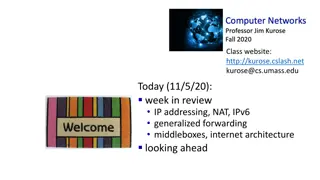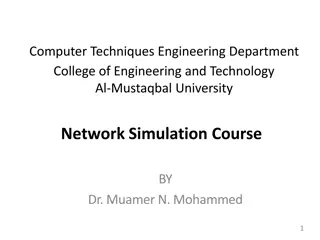Computer Networks CMSC 417 : Spring 2022
Exploring the concepts of Classless Interdomain Routing (CIDR) and Dynamic Host Configuration Protocol (DHCP) in the context of internetworking. CIDR simplifies subnetting by allowing for classless addressing, hiding network hierarchies, and enabling supernetting. Lessons learned from subnetting inc
0 views • 57 slides
Mastering Subnetting: A Comprehensive Overview
Delve into the world of subnetting with Tengku Khairil Ahsyar's course outline covering IP address conversion, subnet mask calculation, and more. Learn about binary, octal, decimal, and hexadecimal number systems along with conversion techniques. Understand the significance of subnetting for efficie
1 views • 25 slides
Network Simulation Course on Variable Length Subnet Masks (VLSM) at Al-Mustaqbal University
This course, conducted by Dr. Muamer N. Mohammed at Al-Mustaqbal University's College of Engineering and Technology, focuses on Variable Length Subnet Masks (VLSM). The lectures cover VLSM techniques, subnetting with and without VLSM, application of VLSM, examples of VLSM implementation, and practic
2 views • 11 slides
Understanding IP Addressing and Routing in Networking
Delve into the fundamentals of IP addressing, CIDR, subnetting, and network layer protocols like TCP and UDP. Explore the intricacies of Internet architecture, NAT, IPv6, and forwarding techniques. Grasp the essentials of IP datagram format, path-selection algorithms, SDN, and more for a comprehensi
0 views • 22 slides
Understanding LAN Technologies and Subnetting in Networking
Subnetting involves dividing larger networks into smaller subnets by borrowing bits from HOST bits. This process does not increase the number of hosts but instead decreases hosts by losing two host IP addresses for each subnet. Different LAN technologies like Ethernet and Token Ring are used in netw
0 views • 23 slides
Understanding IPv4 Addressing and Classes
Explore the fundamentals of IPv4 addressing including subnetting, VLSM, summarization, subnet masks, CIDR values, available host addresses, and broadcast addresses. Learn about IPv4 classes A, B, C, and D, their formats, usage for different network sizes, netmask details, IP address ranges, and more
0 views • 38 slides
Understanding Subnet Mask in Network Simulation Course
Dive into the world of subnet masks and CIDR notations in the context of network simulation. Learn to determine subnet masks, divide networks, and configure routers to optimize network efficiency. Practice subnetting with exercises and explore default subnet masks and CIDR values for enhanced networ
0 views • 12 slides
Understanding NAT and IPv6 in Computer Networking
This lecture covers Network Address Translation (NAT) and IPv6 basics in computer networking. It explains how NAT helps in connecting multiple devices to the internet with limited IPv4 addresses, the concept of public and private IP addresses, and the transition to IPv6 for addressing constraints. V
1 views • 31 slides
Efficient Network Design with Variable Length Subnet Mask
Variable-Length Subnet Masking (VLSM) offers a more efficient way of subnetting a network compared to classical subnetting. By using different subnet masks for different networks, VLSM allows for a more optimal utilization of IP addresses. This involves determining the number of host bits needed for
0 views • 15 slides








